One of the first things that strikes a Tokyo resident who goes to Kyoto is the landscape. It is devoid of the numerous overhead train bridges that dot ( and rather spoil ) the landscape. There are very few high rise buildings giving the place an “open” look. The whole of Kyoto is a like big tourist place. A native Japanese described it as “the most Japanese city”. But I would say that there are places that lend it a decidedly Western look, especially the portion of the city around Kawaramachi dori. One other thing that catches your eye is the fact that streets are named, making it easier for the tourist to follow the map. Kyoto has a very good bus transport and very few trains. And some of the trains are really quaint. These have just one car and it that old look that adds to the charm of the train. They are old indeed. This is the train to Arashiyama from Kitanohakobai-cho station which I refer to again later).
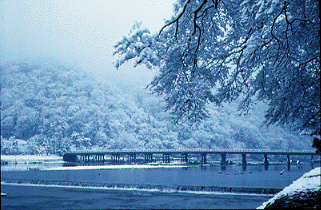 And at times these trains share the roads with the vehicular traffic, with train stops in the middle of the road !! Understandably, they can’t have stops near the edge of the streets like the bus. The first time I saw railway tracks on the road, I thought these must be the vestiges of a train service long ago, but no they are still being used !!
Kyoto can be expensive as far as hotels go. We stayed at a Japanese hotel near Kyoto train station on the JR side of the railway station. Japanese hotel, I say, because we were required to take off our shoes at the entrance and wear those sulippa, like the ones worn inside a traditional Japanese house. We cannot wear our shoes in side the hotel. We had a smallish room with attached bath prompting the comment that it was half Japanese half westernized hotel. A night’s stay cost us $9200. Everything else is extra. You need to use coins to use the TV, much like using a telephone. There is a TV near the reception, if you would like to watch free TV. And you are required to carry your own towel. Towels rent at 100 yen a piece.
Walking is the best way to explore a city and Kyoto is no exception. Incidentally, the tourist map suggests some walking routes in Kyoto. One of them in the Higashiyama area starts at the Kiyomizu temple and goes all the way to Heien Jingu shrine, two of the most popular spots in Kyoto. Among the interesting points along this route are the Ryozan Kannon temple and the Maruyama Park. The Ryozan Kannon temple has a huge statue of Buddha, towering high above everything else around it with a backdrop of mountains and is a must see.
Wherever you go, you find temples and shrines in Kyoto and it is just impossible to cover them all in the two days we had at our disposal. Needless to say, we went to the “famous ones”, identified by a Japanese friend. Most of these temples require you to buy a ticket, the proceeds from which, I assume, are used for the upkeep of the temple and shrines.
And at times these trains share the roads with the vehicular traffic, with train stops in the middle of the road !! Understandably, they can’t have stops near the edge of the streets like the bus. The first time I saw railway tracks on the road, I thought these must be the vestiges of a train service long ago, but no they are still being used !!
Kyoto can be expensive as far as hotels go. We stayed at a Japanese hotel near Kyoto train station on the JR side of the railway station. Japanese hotel, I say, because we were required to take off our shoes at the entrance and wear those sulippa, like the ones worn inside a traditional Japanese house. We cannot wear our shoes in side the hotel. We had a smallish room with attached bath prompting the comment that it was half Japanese half westernized hotel. A night’s stay cost us $9200. Everything else is extra. You need to use coins to use the TV, much like using a telephone. There is a TV near the reception, if you would like to watch free TV. And you are required to carry your own towel. Towels rent at 100 yen a piece.
Walking is the best way to explore a city and Kyoto is no exception. Incidentally, the tourist map suggests some walking routes in Kyoto. One of them in the Higashiyama area starts at the Kiyomizu temple and goes all the way to Heien Jingu shrine, two of the most popular spots in Kyoto. Among the interesting points along this route are the Ryozan Kannon temple and the Maruyama Park. The Ryozan Kannon temple has a huge statue of Buddha, towering high above everything else around it with a backdrop of mountains and is a must see.
Wherever you go, you find temples and shrines in Kyoto and it is just impossible to cover them all in the two days we had at our disposal. Needless to say, we went to the “famous ones”, identified by a Japanese friend. Most of these temples require you to buy a ticket, the proceeds from which, I assume, are used for the upkeep of the temple and shrines. 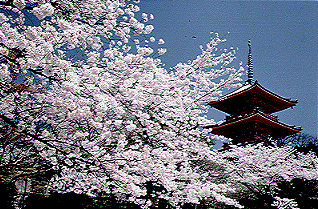 Kiyomizu temple is among the most popular temples in Japan. It is perched on a cliff and commands a very good view of the Kyoto skyline. At the other end of the walking route is the Heien Jingu shrine. The bright orange colours of the shrine are a striking contrast to the landscape and make it stand out. Needless to say, it looks very pretty. At the back of the shrine is a 100 year old garden. It will take you about an hour at each of these two places.
At about a 30 minute walk from here is the Kyoto Imperial Palace. You need to get special permission in advance to go inside the castle. For a foreigner, it is relatively easy. You should plan to get it two or three days in advance, before planning to visit Kyoto. During the spring and autumn, the palace is thrown open to the public for a few days during which period permission is not required to see the palace.
Nijo Castle is one stop that no tourist should miss. Do not be fooled by its less than impressive looks from the outside.
Kiyomizu temple is among the most popular temples in Japan. It is perched on a cliff and commands a very good view of the Kyoto skyline. At the other end of the walking route is the Heien Jingu shrine. The bright orange colours of the shrine are a striking contrast to the landscape and make it stand out. Needless to say, it looks very pretty. At the back of the shrine is a 100 year old garden. It will take you about an hour at each of these two places.
At about a 30 minute walk from here is the Kyoto Imperial Palace. You need to get special permission in advance to go inside the castle. For a foreigner, it is relatively easy. You should plan to get it two or three days in advance, before planning to visit Kyoto. During the spring and autumn, the palace is thrown open to the public for a few days during which period permission is not required to see the palace.
Nijo Castle is one stop that no tourist should miss. Do not be fooled by its less than impressive looks from the outside. 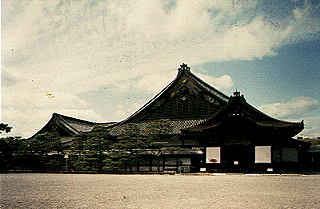 Nijo Castle has been designated as a World Heritage Site and for a valid reason too. Inside the castle is Ninomaru Palace, which houses living quarters and some offices. A leaflet in English describing the various parts of the Nijo Castle is provided at the entrance of Ninomaru Palace. Inside the castle are living quarters, on the walls of which are some of the most exquisite paintings you have seen. One of the unique things about the castle is its “Nightingale Floor”. It squeaks when walking on the floor of the castle. This was to warn the residents of the castle of any intruders. The garden that is attached to the palace, Ninomura Garden is very pretty too.
One more must-see stop in Kyoto is the Kinkakuji temple. Do not confuse it with the Ginkakuji temple. The second and third floors of this temple are covered with gold foil. It is situated at the edge of a pond, Kyoto-chi (Mirror pond ).
Nijo Castle has been designated as a World Heritage Site and for a valid reason too. Inside the castle is Ninomaru Palace, which houses living quarters and some offices. A leaflet in English describing the various parts of the Nijo Castle is provided at the entrance of Ninomaru Palace. Inside the castle are living quarters, on the walls of which are some of the most exquisite paintings you have seen. One of the unique things about the castle is its “Nightingale Floor”. It squeaks when walking on the floor of the castle. This was to warn the residents of the castle of any intruders. The garden that is attached to the palace, Ninomura Garden is very pretty too.
One more must-see stop in Kyoto is the Kinkakuji temple. Do not confuse it with the Ginkakuji temple. The second and third floors of this temple are covered with gold foil. It is situated at the edge of a pond, Kyoto-chi (Mirror pond ).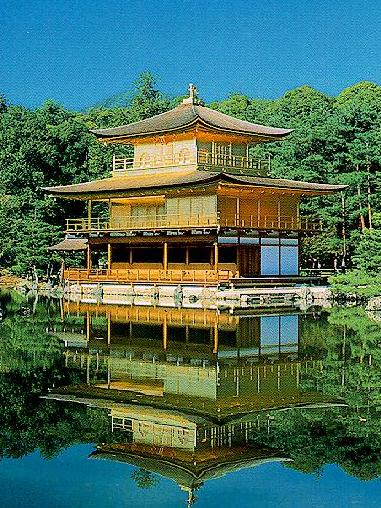 On a calm day, when there is no breeze, you can see the complete reflection in water. As you walk around it, there is a flight of stairs that leads you to a kind of “observation deck”. Not that something has been constructed there. It offers another good view of the temple among dense foliage.
Arashiyama in western Kyoto, offers relaxing surroundings and is an ideal place for picnicking. A 30 minute walk from Kinkakuji temple takes you to the Kitanohakubai-cho station of the Kitano line from where you can take a train to Arashiyama. You need to change trains at Katabiranotsuji station, where you get onto the Arashiyama line on platform 1. The trains are very quaint and give you a glimpse of the railways of the olden days. It is called the Keifuku Electric Railway. In this modern days, when all the trains are electric, the fact that it is explicitly referred to as Electric Railway, refers to its old roots. The trains have just one car and there is only a single track for trains in both directions although at places it there is a double track to allow for trains in opposite directions to pass each other. On reaching Arashiyama, take a left and a short walk takes you to the Togetsukyo bridge over the Katsura river. Around you are mountains, providing the place with a very scenic look. Along the river side is a park and is an ideal place to have a picnic.
For the movie buffs, Kyoto has its own Universal studios. If you are in Arashiyama, take the Arashiyama line to Uzumasa and a short walk takes you to the Toei Eigamura, the place where Japanese movies are made.
On a calm day, when there is no breeze, you can see the complete reflection in water. As you walk around it, there is a flight of stairs that leads you to a kind of “observation deck”. Not that something has been constructed there. It offers another good view of the temple among dense foliage.
Arashiyama in western Kyoto, offers relaxing surroundings and is an ideal place for picnicking. A 30 minute walk from Kinkakuji temple takes you to the Kitanohakubai-cho station of the Kitano line from where you can take a train to Arashiyama. You need to change trains at Katabiranotsuji station, where you get onto the Arashiyama line on platform 1. The trains are very quaint and give you a glimpse of the railways of the olden days. It is called the Keifuku Electric Railway. In this modern days, when all the trains are electric, the fact that it is explicitly referred to as Electric Railway, refers to its old roots. The trains have just one car and there is only a single track for trains in both directions although at places it there is a double track to allow for trains in opposite directions to pass each other. On reaching Arashiyama, take a left and a short walk takes you to the Togetsukyo bridge over the Katsura river. Around you are mountains, providing the place with a very scenic look. Along the river side is a park and is an ideal place to have a picnic.
For the movie buffs, Kyoto has its own Universal studios. If you are in Arashiyama, take the Arashiyama line to Uzumasa and a short walk takes you to the Toei Eigamura, the place where Japanese movies are made. 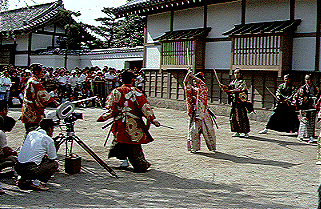 Eiga is the Japanese word for movies and mura means village. So it is literally a Movie-Village. If you do not speak or speak Japanese, then it is a good idea to go with a Japanese friend to help you. Among the various things to see is the Kita-san Yaji-san show which is based in the Edo period, the SFX Chamberland or the horror chamber. You also find environs of the Edo and Meiji period in Eigamura. You need spend from two to four hours or even more depending on your interest.
To find out information and maps of Kyoto, the Tourist Information Center of the Japan National Tourist Organization is a good place.
Eiga is the Japanese word for movies and mura means village. So it is literally a Movie-Village. If you do not speak or speak Japanese, then it is a good idea to go with a Japanese friend to help you. Among the various things to see is the Kita-san Yaji-san show which is based in the Edo period, the SFX Chamberland or the horror chamber. You also find environs of the Edo and Meiji period in Eigamura. You need spend from two to four hours or even more depending on your interest.
To find out information and maps of Kyoto, the Tourist Information Center of the Japan National Tourist Organization is a good place.
![]()